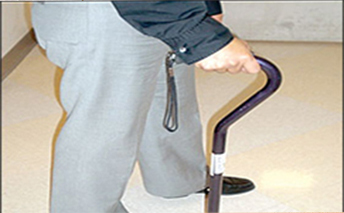I am often told by my physical therapy patients that they are afraid to be “dependent” on using their cane or device. Once a person makes functional improvements and strength gains, it is common to stop using the assistive device consistently. This decision could lead to a false sense of safety and possible continued gait problems. The cane was initially issued to help restore a normal gait pattern, decrease weight bearing through a leg joint or assist with balance. The cane is ideally used in the opposite hand because of the normal reciprocal pattern of walking. So if it is the right leg that is problematic then the cane is used in the left hand. As the right leg moves forward, the cane and left arm are also moving forward simultaneously.
People who need a cane to restore a normal gait pattern may be able to walk short distances without the cane but ultimately find that their gait pattern deteriorates with longer distances. After a certain distance walked without the cane, joint pain or a limp may result. This can lead to further joint stresses, exacerbation of arthritic conditions and lower endurance from less walking performed. The cane can help preserve joint function for longer periods of time by taking the load off during the stance phase of gait. When the normal gait pattern turns into a limp, there are further problems possible for the other leg that is then working harder. It is hard to believe that this awkward way of walking can be deemed by some to be preferable to using a cane.
For those people that find themselves reaching out for furniture and walls to keep them steady, a cane may be just the thing for you. Sometimes a cane is enough to increase gait steadiness and help with fall prevention. Too often I see people reaching for furniture that is not within reach. This presents with an already unsteady person changing their posture and gait to find an object instead of putting efforts toward normalizing gait and posture. This is a very unsafe practice and should be corrected. Physical Therapy for balance deficits routinely helps to avoid falls through gait training, patient education, fall prevention education, balance and proprioception exercises as well as strength training programs.
Many people will graduate off a cane after recovery of an ankle or knee sprain, but more serious joint conditions and balance problems may necessitate its ongoing use. I am troubled when I hear the term “dependent” as if it is something harmful. Some people would still rather walk “funny” than to admit they need the cane. For these cases, can’t we just admit that when there is positive gait changes the cane is needed and the advantages should outweigh any feelings of dependency.


Hi, this is a comment.
To get started with moderating, editing, and deleting comments, please visit the Comments screen in the dashboard.
Commenter avatars come from Gravatar.